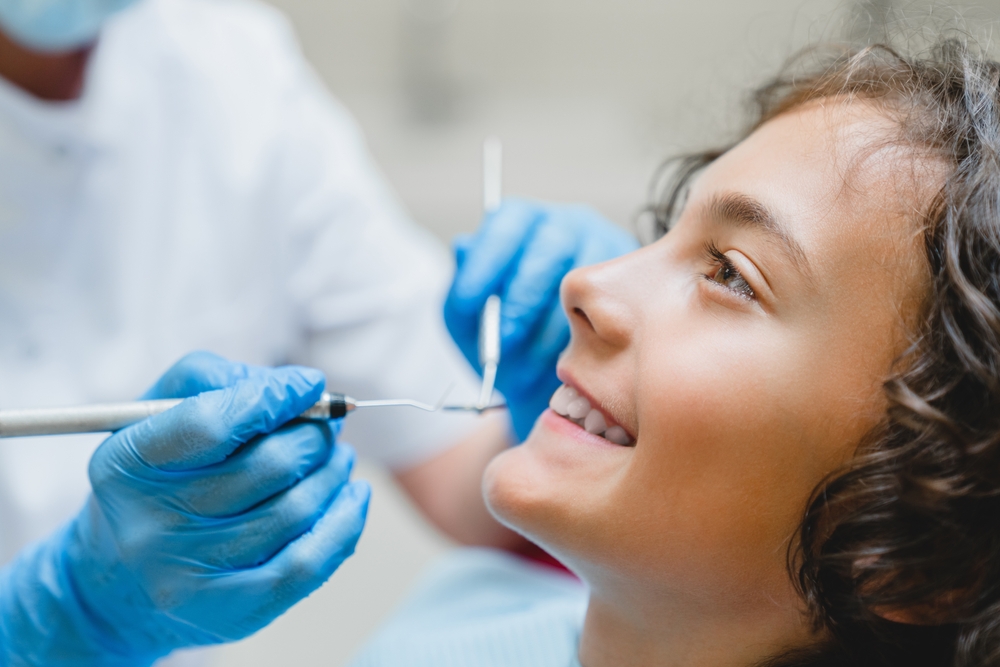
If you’ve been told or you suspect that your child has a crossbite, you probably have a lot of questions. What caused the crossbite? Is early intervention needed or can treatment wait until they’re older? As certified specialists in orthodontics, Dr. Vishal Sharma, Dr. Everett Lin and Dr. Julia Koo are experts in diagnosing, preventing and treating crossbites in kids, teens and adults. In this post, they’ll be covering everything you need to know about this bite issue, including when early interceptive orthodontics is recommended.
What is a Crossbite?
A crossbite is a type of malocclusion. Malocclusion, or a “bad bite,” is when the upper and lower teeth don’t come together properly when the mouth is closed due to dental and/or skeletal irregularities.
With a crossbite, one or more of the lower teeth sit in front of the upper teeth. A crossbite can be dental (i.e., related to the positioning of the teeth) or skeletal (i.e., related to the jaw) and occur on one or both sides of the mouth.
There are two main types of crossbites:
- Anterior Crossbite – An anterior crossbite, or front crossbite, is when the teeth in the front of the mouth are involved.
- Posterior Crossbite – A back crossbite, or posterior crossbite, involves the back teeth.
Wait, so aren’t a crossbite and underbite the same thing? No. With a crossbite, some of the bottom teeth fit outside of some of the top teeth. When a patient has an underbite, on the other hand, the entire lower jaw is in front of the upper jaw.
What Causes a Crossbite?
We inherit many of our dental and skeletal traits from our parents, which is why a crossbite is often genetic. It can happen if a child is born with a too small or narrow upper jaw and/or too large lower jaw. A crossbite can also be related to certain congenital conditions, including a cleft lip and palate.
Other causes of a crossbite include:
- Delayed Loss of Baby Teeth
Sometimes, a child’s baby teeth get loose but then tighten up again, preventing the permanent teeth from erupting. Known as over-retained baby teeth, this can lead to a crossbite with one or multiple teeth.
- Mouth Breathing
Mouth breathing, which generally happens when a child is asleep, can alter facial growth, resulting in a narrow upper jaw that may lead to the development of a crossbite. When kids already have a small upper jaw and are chronic mouth breathers, it can make the issue worse.
- Oral and Myofunctional Habits
Prolonged oral habits like thumb sucking and pacifier use, especially if they’re very vigorous, create pressure that may interfere with jaw and facial growth, often causing the palate to narrow.
A meta-analysis published in the International Journal of Orthodontics found that pacifier use after the age of 3 contributed to a higher incidence of posterior crossbite. Helping your toddler stop thumb sucking or using a pacifier by age 2 or 3 can be useful for preventing changes in the palate.
Myofunctional habits, like tongue thrust and other abnormal swallowing patterns, can create the same pressure as sucking a thumb or pacifier. Again, this can lead to a high, narrow palate, making the development of a crossbite more likely.
- Trauma
When primary or permanent teeth are displaced because of an injury, a crossbite can form.
What Problems Can a Crossbite Cause if Not Treated?
Does a crossbite need to be corrected? Yes! Any time the bite is misaligned, it can lead to a host of complications.
What problems can a crossbite cause if not treated? It can result in:
- Excessive or uneven wear of the tooth enamel
- Lopsided jaw growth since patients often shift the jaw to one side to compensate
- Cracked or chipped teeth
- Injury to protruding lower teeth
- Increased risk of tooth decay and gum disease
- Receding gums that put the tooth roots at risk for infection
- Difficulty biting and chewing properly
- Speech issues
- Jaw and tooth pain
- Temporomandibular joint (TMJ) pain and dysfunction
- Headaches
- Trouble completely closing the jaw

Does a Crossbite in Kids Require Early Intervention?
Sometimes. We’ll often wait until the teenage years to treat a minor, dental crossbite. Since correcting a dental crossbite may only involve shifting one or two teeth into place, treatment can be effective for patients of all ages, even adults.
When the problem is skeletal, particularly a skeletal posterior crossbite, it could require early interceptive orthodontics, though it will depend on the complexity and your child’s unique anatomy. This is because, not only is it easier to widen the upper jaw when a child is in a period of rapid growth, early intervention also prevents the facial asymmetries that can develop when a child moves the jaw to the side to compensate for the misalignment of their teeth.
Dr. Sharma, Dr. Lin and Dr. Koo are able to accurately diagnose a crossbite in kids and determine the type and timing of treatment to bring about the best results. If early orthodontics is needed, they’re experts in dentofacial orthopedics, which means using orthodontic appliances to guide jaw growth.
The Canadian Association of Orthodontists recommends children have their first orthodontic evaluation by age 7. At this age, the first permanent molars are in, giving us an idea of how a child’s bite is developing, and it’s early enough to achieve skeletal correction in order to help the permanent teeth erupt into their ideal places. If treatment isn’t necessary right away, we’ll simply monitor your child over the years until the time is right.
How is a Crossbite Corrected in Kids?
Phase 1 Orthodontic Treatment
Phase 1 orthodontic treatment, or early interceptive orthodontic treatment, is when we use an orthodontic appliance, usually for skeletal correction, while a child is still growing and has a mix of baby teeth and permanent teeth. Depending on your child’s specific case, phase 1 treatment would begin sometime between ages 7 and 10.
If your kiddo’s thumb sucking habit, pacifier use or tongue thrust is putting them at risk for skeletal changes, treatment could actually begin earlier. In this case, we would try to prevent a crossbite from developing at all by using a habit-breaking appliance to stop the oral habit.
Once a posterior crossbite is already beginning to emerge or if it’s genetic, expansion, or widening the upper jaw and palate, is the most common type of phase 1 orthodontic treatment. In children, the upper jaw is made up of two halves that meet in the middle at what’s known as the midline suture. The suture doesn’t fuse until around puberty and responds to pressure from an orthodontic appliance, such as a rapid palatal expander.
The expander sits against the roof of the mouth and is activated by turning a key. This gently pushes the halves of the upper jaw apart. Once the desired amount of skeletal expansion is achieved, the appliance is left in place for a bit longer to allow new bone to form in the middle, stabilizing the results.
After removing the expander, we may or may not create a custom retainer for your child to wear. They’ll wear the retainer during a resting period where the remainder of the permanent teeth are allowed to come in naturally.
Once the permanent teeth are in, around age 12 or 13, the majority of kids will then kick off phase 2 orthodontic treatment. This is when Dr. Sharma, Dr. Lin or Dr. Koo uses braces or Invisalign Teen to straighten the teeth and finetune your child’s bite.
When phase 1 orthodontic treatment is needed to treat a posterior crossbite, it can help your child avoid the need for corrective jaw surgery, extractions or lengthy, complicated treatment later in life. It has the added benefit of helping the permanent teeth to erupt into the correct places and expanding the airway, which may correct mouth breathing, snoring and sleep-disordered breathing in some kids.
Braces
For a mild posterior crossbite or an anterior crossbite, we’ll often hold off until your child is a tween or teenager and use braces for crossbite correction. Both metal braces and clear braces are effective. The braces might be paired with rubber bands to get the corrective force needed to bring the upper and lower arch into healthy alignment while we’re straightening the teeth.
If your child is in their mid-teen years and they have a skeletal, posterior crossbite, the midline suture may be too tight for a rapid palatal expander to be effective. In these cases, we’ll have to use another appliance or auxiliaries in conjunction with braces to achieve stable results.
Invisalign
Can Invisalign fix a crossbite? As a Diamond Invisalign Provider*, we’ve helped patients of all ages straighten their teeth with clear aligners, even those with a crossbite. Similar to braces treatment, Invisalign for crossbite correction will generally involve rubber bands, as well as Invisalign attachments (tooth-colored buttons that are bonded to the teeth). The attachments give us the leverage to achieve more complex tooth movements, while the rubber bands bring the bite into alignment as the aligners shift the teeth.
In cases of a skeletal posterior crossbite, we may recommend phase 1 orthodontic treatment followed by Invsialign Teen. If your child missed the window for early interceptive orthodontics, our orthodontists can help you weigh the different options to fix the crossbite.

Crossbite Treatment for Kids in Surrey and Langley, BC
If your child has been diagnosed with a crossbite or you believe they may be developing one, schedule a consultation at Aura Orthodontics. Our Guildford, Scottsdale and Langley orthodontists will take diagnostic records and perform an exam to develop an accurate diagnosis. They’ll walk you through their findings and make recommendations on the best time to start treatment.
At our bright, modern practice, we strive to put kids and parents at ease and make the process educational and fun. Whether your child needs early intervention or they’ll simply be monitored during occasional growth and development check-ups, we’re confident they’ll actually look forward to their appointments!
*This ranking is based on Invisalign use data, and is not necessarily indicative of clinical superiority.





